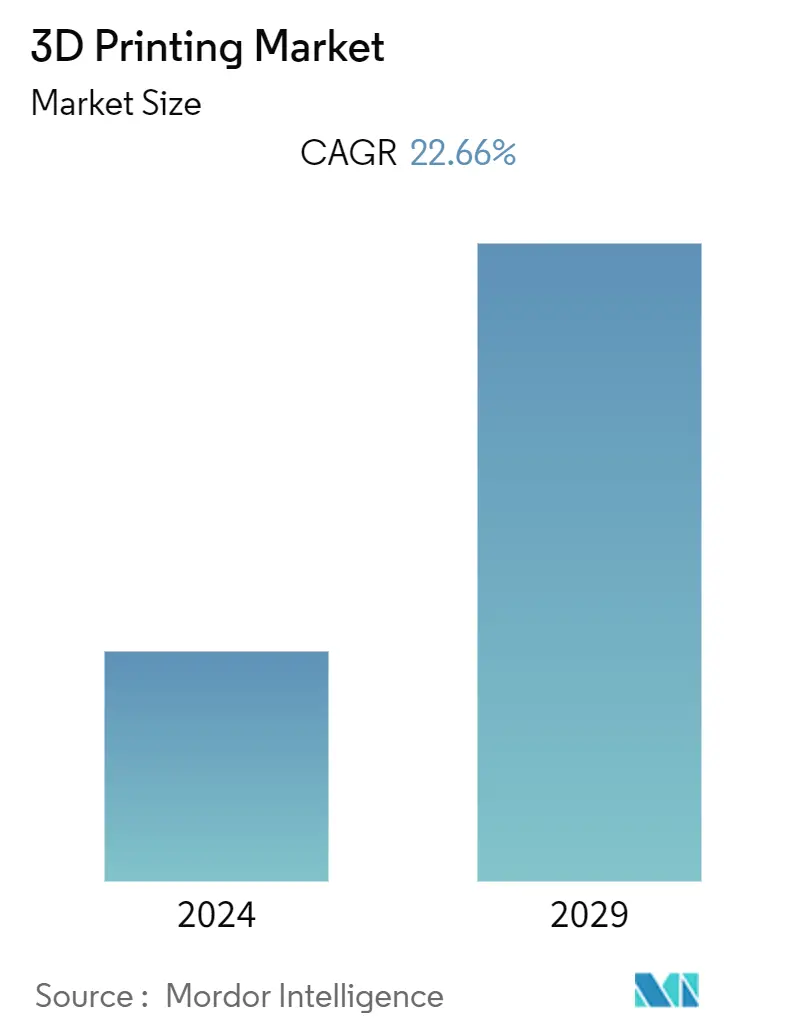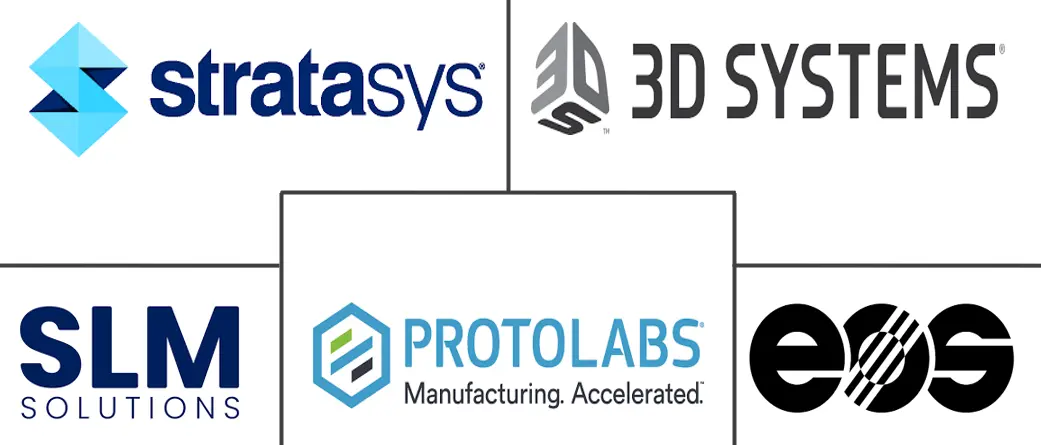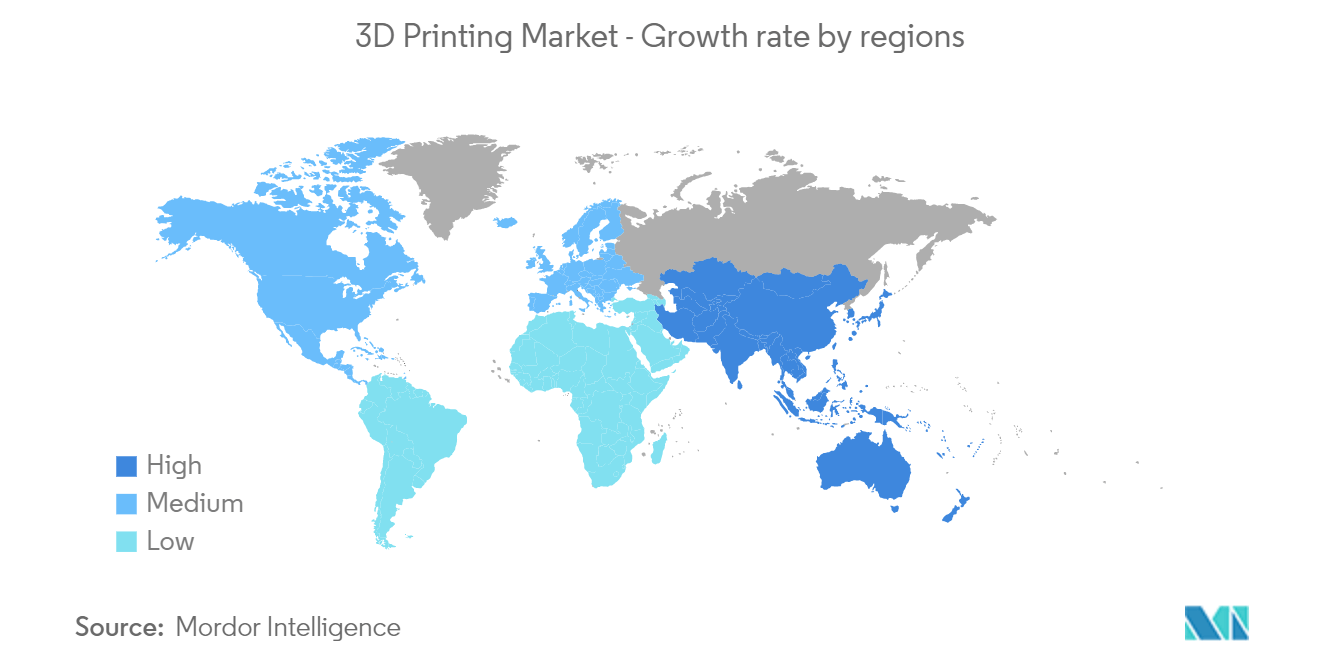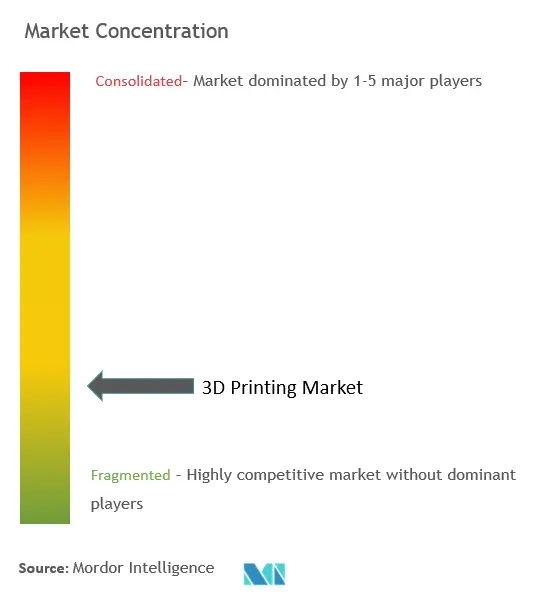3D Printing Market Size

| Study Period | 2019 - 2029 |
| Base Year For Estimation | 2023 |
| CAGR (2024 - 2029) | 22.66 % |
| Fastest Growing Market | Asia Pacific |
| Largest Market | North America |
| Market Concentration | Low |
Major Players
*Disclaimer: Major Players sorted in no particular order |
3D Printing Market Analysis
The 3D Printing Market is expected to register a CAGR of 22.66% during the forecast period.
This growth of the 3D printing market is pinned to the trend that large manufacturers are increasingly using the technology for mass production.
- With rapid advancements in material composition, such as the emerging use cases of polymers and metals, additive manufacturing is evolving from a prototyping tool to a functional part of fabrication. New materials, shorter lead times, and innovative finishes while adhering to standards (FDA, ASTM, and ISO) enable the technology to be integrated into manufacturing processes.
- Further, the decreased prices of additive manufacturing-based machines, growing expertise, and awareness have increased 3D manufacturing adoption. Newer and advanced fused deposition modeling methods have enabled the use of diverse materials, thereby boosting widespread adoption across various industries over recent years.
- Governments worldwide have already started investing in R&D on 3D printing, which has positively impacted technology propagation and adoption. For instance, in February 2022, the government of India aims to capture 5% of the global market share in 3D printing by adding nearly USD 2-3 billion to the GDP in the coming 2-3 years. The government plans to create 50 India-specific technologies for material, machine, process, and software to make India a 3D-printed design and manufacturing hub.
- However, as technology advances, additive manufacturing challenges the traditional forms of Intellectual Property (IP) protection. It significantly boosts the illegal usage of printed weapons and drugs, which is expected to hinder the market's growth. Also, the market is constrained by the high equipment costs needed to achieve substantial economies of scale. Furthermore, the lack of an international standards body regulating manufacturers limits the market's standardization structure.
- COVID-19 pandemic increased the demand for 3D printing. 3D printing systems are rapidly being utilized to create medical devices, personal protective equipment (PPE), testing devices, and even emergency dwellings to isolate persons suffering from the disease. The various technological advancements, such as AI and ML, further augment the adoption of 3D Printing devices.
- The pandemic hit the metal and polymer 3D printing markets hard. Whereas growth has been slower for metals and polymers than pre-pandemic expectations, these markets are returning rapidly with growing demand from end-user industries.
3D Printing Market Trends
Rapid Advancement in Printing Technologies and Materials to Drive Market
- Rapid developments in production technologies and materials are helping to drive demand for the 3D printing market. The rapid growth of 3D printing techniques and materials is taking place worldwide, opening up new possibilities in 3D printing and creating complex and custom design products.
- For example, new printing technologies like selective laser sintering (SLS) and direct metal laser sintering (DMLS) make it possible to create complex metal parts with high precision. This is opening up new opportunities for 3D printing in the automotive, aerospace, and defense industries. With space exploration witnessing a paradigm shift, the demand for SLS printing is expected to mount, with an increasing number of countries gearing up to launch satellites.
- New materials like carbon fiber and graphene are also being developed for 3D printing. These materials are solid and lightweight, making them ideal for various applications. For example, carbon fiber is used to create 3D-printed racing car parts, and graphene is used to create 3D-printed medical implants. For instance, in November 2022, Inkbit, a Massachusetts-based additive manufacturing company, introduced its latest additive manufacturing material, the Titan Tough Epoxy 85 elastomer, at Formnext. This material improves performance for applications requiring high accuracy and production-grade mechanical properties.
- The rapid advancement in printing technologies and materials is one of the key trends contributing to the growth of the 3D printing market. As these technologies continue to develop, manufacturers can use 3D printing in various end-use applications.

North America Holds the Largest Share in the Market
- The North American region is expected to dominate the 3D printing market as the region is an early adopter of technology. A series of new product launches and innovations are expected to augment market growth. Several 3D printing solution providers worldwide are expanding their presence in the North American market for an enhanced market presence.
- Several players in the United States market are expanding their focus on 3D printing research and development. In May 2023, Siemens announced its increasing emphasis on 3D printing initiatives in the United States to accelerate the transformation of the US additive manufacturing industry through serial additive manufacturing. With these initiatives, the company is working on bringing fundamental changes to the landscape, end-to-end, from product to machine to manufacturing.
- The region is also witnessing a series of investments in North America's healthcare, aerospace and defense, industrial, and consumer products industries, which are expected to grow significantly. In November 2022, Med-tech start-up Axial3D received an investment round of USD 15 million led by a strategic investment of 10 million USD from Stratasys. The collaboration between the two companies would provide a combined offering to make 3D printing solutions that are patient-specific for hospitals and medical device manufacturers more accessible, pushing for its adoption as a mainstream healthcare solution.
- In addition, various government organizations, such as NASA, have identified that substantial investments in 3D printing technologies can contribute considerably to space applications and develop zero-G technologies, driving the market's growth.
- Fitness trackers and smart apparel are also expected to drive factors for 3D printing technology in the United States. Also, changing consumer preferences and a rising need for customization have brought about a need to create flexible bands and electronics systems that could be realized using 3D printing technology, thereby driving its growth.

3D Printing Industry Overview
The 3D printing market is fragmented with global and regional players. The key players in the market, like Stratasys Ltd, 3D Systems Corporation, EOS GmbH, General Electric Company (GE Additive), and Sisma SPA, among others, are making partnerships, mergers, acquisitions, and investments in the market to retain their market position.
In April 2023, Stratasys Ltd., one of the leaders in polymer 3D printing solutions, acquired Covestro AG's additive manufacturing materials business. The acquisition includes R&D facilities and activities, global development, and sales teams in Europe, the United States, and Asia.
In October 2022, AML3D Australian metal 3D printing expanded its partnership with Boing aircraft manufacturer. Boeing tasked AML3D earlier this year with 3D printing aluminum prototype airplane components as part of an intensive testing procedure. They were tested against the requirements of AS9100D quality assurance for 'fly' parts. Building on this contract, it has now been decided to broaden the scope of the project to include additional 3D-printed components, increasing the agreement's value by 150%.
In June 2022, Israel-based Stratasys planned the expansion of its 3D printing sector in India. Ashok Leyland, Hero MotoCorp, AIIMS, Symbiosis, and IITs are among the company's clientele, with extensive experience in design prototyping, manufacturing tools, and production parts.
3D Printing Market Leaders
-
Stratasys Ltd.
-
3D Systems Corporation
-
Proto Labs Inc.
-
SLM Solutions Group AG
-
EOS GmbH
*Disclaimer: Major Players sorted in no particular order

3D Printing Market News
- October 2022: PostProcess Technologies and EOS have launched a distribution relationship to provide EOS clients with a fully automated and sustainable depowering solution. According to PostProcess, the Variable Acoustic Displacement (VAD) technology solution will complement the EOS printer product line and automate gross depowering for 3D printed parts. The partnership makes it easier for consumers to obtain post-printing solutions, allowing for complete process digitization.
- August 2022: India's central government's Department of Empowerment of Persons with Disabilities (DEPWD) is preparing to introduce 3D printing technology to gradually replace manual customization of devices, which is currently the norm, to improve quality of life and bring more precision to assistive devices such as artificial limbs and spinal braces to enhance mobility of persons with locomotor disabilities. Delhi-based Pt Deendayal Upadhyaya National Institute for Persons with Physical Disabilities (PDUNIPPD) has successfully tested the technology.
- February 2022: The government of India announced a national strategy for 3D printing to encourage collaboration between academia, government, and industry to make India a global hub for designing, developing, and deploying 3D printing.
3D Printing Market Report - Table of Contents
1. INTRODUCTION
- 1.1 Study Assumptions and Market Definition
- 1.2 Scope of the Study
2. RESEARCH METHODOLOGY
3. EXECUTIVE SUMMARY
4. MARKET INSIGTHS
- 4.1 Market Overview
-
4.2 Industry Attractiveness - Porter's Five Forces Analysis
- 4.2.1 Bargaining Power of Suppliers
- 4.2.2 Bargaining Power of Buyers
- 4.2.3 Threat of New Entrants
- 4.2.4 Threat of Substitutes
- 4.2.5 Intensity of Competitive Rivalry
- 4.3 Industry Value Chain Analysis
- 4.4 Impact of COVID-19 on the Market
5. MARKET DYNAMICS
-
5.1 Market Drivers
- 5.1.1 Initiatives and Spending by the Government
- 5.1.2 Ease in Development of Customized Products
-
5.2 Market Challenges
- 5.2.1 High Initial Cost and Skill Shortage
6. MARKET SEGMENTATION
-
6.1 By Technology
- 6.1.1 Stereo Lithography (SLA)
- 6.1.2 Fused Deposition Modeling (FDM)
- 6.1.3 Electron Beam Melting
- 6.1.4 Digital Light Processing
- 6.1.5 Selective Laser Sintering (SLS)
- 6.1.6 Other Technologies
-
6.2 By Material Type
- 6.2.1 Metal
- 6.2.2 Plastic
- 6.2.3 Ceramics
- 6.2.4 Other Material Types
-
6.3 By End-user Industry
- 6.3.1 Automotive
- 6.3.2 Aerospace and Defense
- 6.3.3 Healthcare
- 6.3.4 Construction and Architecture
- 6.3.5 Energy
- 6.3.6 Food
- 6.3.7 Other End-user Industries
-
6.4 By Geography
- 6.4.1 North America
- 6.4.2 Europe
- 6.4.3 Asia-Pacific
- 6.4.4 Rest of the World
7. COMPETITIVE LANDSCAPE
-
7.1 Company Profiles
- 7.1.1 Stratasys Ltd
- 7.1.2 3D Systems Corporation
- 7.1.3 EOS GmbH
- 7.1.4 General Electric Company (GE Additive)
- 7.1.5 Sisma SPA
- 7.1.6 ExOne Co.
- 7.1.7 SLM Solutions Group AG
- 7.1.8 Proto Labs Inc.
- 7.1.9 Hewlett Packard Inc.
- 7.1.10 Nano Dimernsion Ltd
- 7.1.11 Ultimaker BV
- *List Not Exhaustive
8. INVESTMENT ANALYSIS
9. MARKET OPPORTUNITIES AND FUTURE TRENDS
** Subject To Availablity3D Printing Industry Segmentation
Additive manufacturing, or 3D printing, is an automated process of creating rapid prototypes and functional end-use parts. It transforms virtual designs from computer-aided design (CAD) software into thin, virtual, horizontal layer-wise cross-sections until the model is complete. The 3D printing market's scope categorizes the various technologies used in 3D Printing, ranging from SLA, FDM, SLS, DLM, EBM, etc.
The study also categorizes an in-depth analysis of multiple applications of 3D Printing across various end-user industries, such as automotive, aerospace, defense, healthcare, construction, and architecture. The categorization is also based on material types, such as metals, plastics, and ceramics.
The 3D Printing Market is segmented by printer type (desktop and industry-grade), technology (stereo lithography, fused deposition modeling, electron beam melting, digital light processing, and selective laser sintering), material type (metal, plastic, and ceramics), end-user industry (automotive, aerospace, and defense, healthcare, construction and architecture, energy, and food), and by geography.
The market sizes and forecasts are provided in terms of value (in USD) for all the above segments.
| By Technology | Stereo Lithography (SLA) |
| Fused Deposition Modeling (FDM) | |
| Electron Beam Melting | |
| Digital Light Processing | |
| Selective Laser Sintering (SLS) | |
| Other Technologies | |
| By Material Type | Metal |
| Plastic | |
| Ceramics | |
| Other Material Types | |
| By End-user Industry | Automotive |
| Aerospace and Defense | |
| Healthcare | |
| Construction and Architecture | |
| Energy | |
| Food | |
| Other End-user Industries | |
| By Geography | North America |
| Europe | |
| Asia-Pacific | |
| Rest of the World |
3D Printing Market Research FAQs
What is the current 3D Printing Market size?
The 3D Printing Market is projected to register a CAGR of 22.66% during the forecast period (2024-2029)
Who are the key players in 3D Printing Market?
Stratasys Ltd., 3D Systems Corporation, Proto Labs Inc., SLM Solutions Group AG and EOS GmbH are the major companies operating in the 3D Printing Market.
Which is the fastest growing region in 3D Printing Market?
Asia Pacific is estimated to grow at the highest CAGR over the forecast period (2024-2029).
Which region has the biggest share in 3D Printing Market?
In 2024, the North America accounts for the largest market share in 3D Printing Market.
What years does this 3D Printing Market cover?
The report covers the 3D Printing Market historical market size for years: 2019, 2020, 2021, 2022 and 2023. The report also forecasts the 3D Printing Market size for years: 2024, 2025, 2026, 2027, 2028 and 2029.
What are the Leading 3D Printing technologies?
New printing technologies like selective laser sintering (SLS), stereolithography (SLA), and fused deposition modeling (FDM), with other metal printings gaining traction in the 3D Printing Market.
3D Printing Industry Report
The global 3D printing market is on a robust growth trajectory, fueled by technological advancements and a broadening range of applications across industries. With a remarkable CAGR, it's set to reach a substantial valuation by the end of the forecast period, driven by active R&D and a growing preference for prototypes in diverse sectors. The expansion is further supported by the adoption of mixed-material printers and 3D technologies in academic and research centers, alongside a trend towards customization with DIY 3D printers.
North America leads the market, with the Asia Pacific region projected to see the highest growth, driven by rapid industrial advancements. Despite challenges like high prototype costs, the market's future is promising, with significant opportunities for innovation. The industry trends indicate a positive outlook for the 3D printing market, with a focus on market size and market growth. Industry reports provide valuable insights into market segmentation and market value, helping research companies and market leaders understand the market dynamics better.
The market forecast suggests continued growth, supported by detailed industry analysis and industry statistics. The market overview highlights the key industry trends and market data, offering a comprehensive market review. With industry research and industry information at the forefront, the market outlook remains optimistic. Industry sales and market predictions point towards sustained market growth, making it an attractive sector for investment and development.
This report example, available as a report pdf, serves as a crucial resource for understanding the industry's current state and future potential. The industry size and industry outlook are critical for stakeholders to make informed decisions. The report also emphasizes the importance of market segmentation and market value in driving the industry's progress.



